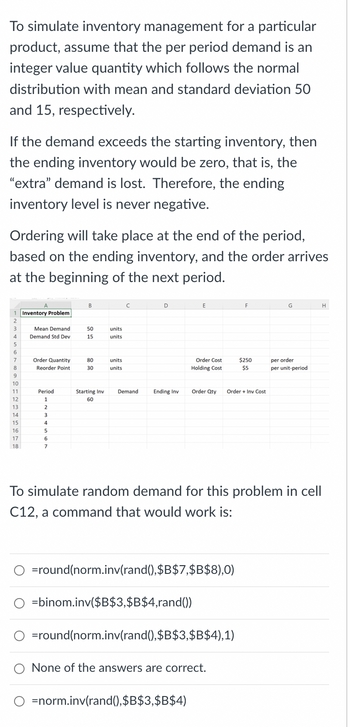
Practical Management Science
6th Edition
ISBN: 9781337406659
Author: WINSTON, Wayne L.
Publisher: Cengage,
expand_more
expand_more
format_list_bulleted
Question
Please do not give solution in image format thanku

Transcribed Image Text:To simulate inventory management for a particular
product, assume that the per period demand is an
integer value quantity which follows the normal
distribution with mean and standard deviation 50
and 15, respectively.
If the demand exceeds the starting inventory, then
the ending inventory would be zero, that is, the
"extra" demand is lost. Therefore, the ending
inventory level is never negative.
Ordering will take place at the end of the period,
based on the ending inventory, and the order arrives
at the beginning of the next period.
2
3
4
5
6
7
8
9
10
11
12
13
14
15
16
17
18
Inventory Problem
Mean Demand
Demand Std Dev
Order Quantity
Reorder Point
Period
1
2
3
4
5
6
7
B
50
15
80
30
units
units
units
units
Starting Inv Demand
60
D
Ending Inv
E
Order Cost
Holding Cost
=round(norm.inv(rand(),$B$7,$B$8),0)
=binom.inv($B$3,$B$4,rand())
Order Qty Order + Inv Cost
=norm.inv(rand(),$B$3,$B$4)
=round(norm.inv(rand(),$B$3,$B$4),1)
F
To simulate random demand for this problem in cell
C12, a command that would work is:
None of the answers are correct.
$250
$5
G
per order
per unit-period
H
Expert Solution
This question has been solved!
Explore an expertly crafted, step-by-step solution for a thorough understanding of key concepts.
Step by stepSolved in 3 steps

Knowledge Booster
Similar questions
- 3 A message travels between the source and the received through Question 3 options: Environment Context Channel Feedbackarrow_forwardAnswer with explanation.arrow_forwardWhich of the following issues is a potential disadvantage of online ads even though the cost per viewer for online ads can be cheaper than conventional TV commercials? Question 21 options: Limited color palettes Inability to overlay text on images Lack of sound Advertising fraud due to scammers and bots Content-licensing headachesarrow_forward
- Assume you are conducting a study to determine the importance of brand names and features of mobile phone handsets. What types of questions would you use—open-ended, closed-ended, scaled?—and why? Suggest six to eight questions you would ask and in what sequence you would ask them.arrow_forward29- Services are intangible and that is a problem for service marketers because customers cannot touch or feel service. Which of the following is MOST effective in overcoming intangibility? Group of answer choices use virtual reality to let customers get a feel for the service use robots or automation technologies offer monetary incentives to customers offer money-back guarantee 30- Department stores are those retailers who Group of answer choices heavily discount prices to undercut other form of retailers lack enough salespeople on the floor, so service is extremely limited carry a broad variety and deep assortment of merchandise carry a wide range of products, each with a limited selection of merchandise 31- Unlike advertising, public relations Group of answer choices is considered a human resource function converts mass media advertising into direct marketing supports promotional efforts by generating free media attention should not be considered part of the…arrow_forwardNational Cranberry Cooperative (Abridged) what is case solutionarrow_forward
- 18. Harmful effects that may result from using mediated channels appear to be larger than critics originally claimed. True Falsearrow_forwardPlease do not give solution in image formate thanku.arrow_forwardQUESTION 33 Customer behavior is a broader term than consumer behavior, covering both individual consumers who buy goods and services for their own use and organizational buyers who purchase business products. O True O False QUESTION 34 Customer behavior is a subset of consumer behavior. O True O Falsearrow_forward
arrow_back_ios
SEE MORE QUESTIONS
arrow_forward_ios
Recommended textbooks for you
 Practical Management ScienceOperations ManagementISBN:9781337406659Author:WINSTON, Wayne L.Publisher:Cengage,
Practical Management ScienceOperations ManagementISBN:9781337406659Author:WINSTON, Wayne L.Publisher:Cengage, Operations ManagementOperations ManagementISBN:9781259667473Author:William J StevensonPublisher:McGraw-Hill Education
Operations ManagementOperations ManagementISBN:9781259667473Author:William J StevensonPublisher:McGraw-Hill Education Operations and Supply Chain Management (Mcgraw-hi...Operations ManagementISBN:9781259666100Author:F. Robert Jacobs, Richard B ChasePublisher:McGraw-Hill Education
Operations and Supply Chain Management (Mcgraw-hi...Operations ManagementISBN:9781259666100Author:F. Robert Jacobs, Richard B ChasePublisher:McGraw-Hill Education
 Purchasing and Supply Chain ManagementOperations ManagementISBN:9781285869681Author:Robert M. Monczka, Robert B. Handfield, Larry C. Giunipero, James L. PattersonPublisher:Cengage Learning
Purchasing and Supply Chain ManagementOperations ManagementISBN:9781285869681Author:Robert M. Monczka, Robert B. Handfield, Larry C. Giunipero, James L. PattersonPublisher:Cengage Learning Production and Operations Analysis, Seventh Editi...Operations ManagementISBN:9781478623069Author:Steven Nahmias, Tava Lennon OlsenPublisher:Waveland Press, Inc.
Production and Operations Analysis, Seventh Editi...Operations ManagementISBN:9781478623069Author:Steven Nahmias, Tava Lennon OlsenPublisher:Waveland Press, Inc.

Practical Management Science
Operations Management
ISBN:9781337406659
Author:WINSTON, Wayne L.
Publisher:Cengage,

Operations Management
Operations Management
ISBN:9781259667473
Author:William J Stevenson
Publisher:McGraw-Hill Education

Operations and Supply Chain Management (Mcgraw-hi...
Operations Management
ISBN:9781259666100
Author:F. Robert Jacobs, Richard B Chase
Publisher:McGraw-Hill Education


Purchasing and Supply Chain Management
Operations Management
ISBN:9781285869681
Author:Robert M. Monczka, Robert B. Handfield, Larry C. Giunipero, James L. Patterson
Publisher:Cengage Learning

Production and Operations Analysis, Seventh Editi...
Operations Management
ISBN:9781478623069
Author:Steven Nahmias, Tava Lennon Olsen
Publisher:Waveland Press, Inc.